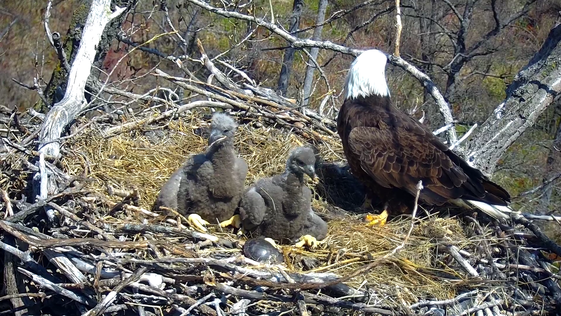|
May 1, 2022
 E1, E2 and Mom
May 1, 2022 - RIP, E2
We had a much happier post prepared for today. Things have changed over the last few days and the bad news to report is that the second chick (referred to as E2) was pushed from the nest yesterday by its older sibling. Nongame staff were contacted and retrieved the chick from the ground as soon as we were made aware of the incident. The nest is roughly 75 feet high. The chick was found alive on the ground below the nest.
The young eagle was able to be quickly brought to the veterinarians at The Raptor Center for care. Upon arrival, the young bird was quiet and got increasing lethargic throughout the exam. A wound was found on its head and it had increased effort to breathe. Throughout the exam, its breathing got more labored, most likely a result from internal trauma. Blood was noted coming from the nares (nostrils) of the bird.
It had a fracture of the humerus very close to the joint in its left wing that impacted the growth plate area. With this kind of fracture, there is not an option to repair it surgically and it cannot be left alone to heal as the bone would heal in a way that would cause chronic problems and pain for the bird.
Because of the very poor prognosis due to the complex fracture and severely progressing signs of internal trauma, the young bird was humanely euthanized to alleviate suffering.
Siblicide in the wild is the killing of a nestling by its sibling and generally only occurs when food sources are scarce. Siblicide is advantageous for the surviving offspring because they have now eliminated most or all of their competition.
The older of the two chicks had been attacking the younger for a few days and got increasingly aggressive when the male parent went missing. The last time he was seen at the nest was on Tuesday, April 24. We don't know what happened to him. Staff and volunteers spent several hours last week surveying the area for sick or dead birds due to the current H5N1 Avian Influenza outbreak in Minnesota. None were found, nor was the male bird. He has not appeared at The Raptor Center as a patient, nor has he been found dead. Their staff has been alerted and will inform us if he turns up at their clinic. It is unlikely he will return to the nest after this long of an absence.
The female is now on her own to hunt, protect and care for her remaining chick. With only one to care for now, we are optimistic that she will be able to continue to raise E1 to fledging.
Nongame would like to thank The Raptor Center, Thomas Demma, the USFWS and Conservation Officer Chris Tetrault for their lightening fast assistance yesterday. It is at least reassuring that the chick didn't suffer with it's injuries for a long time. It has been a sad week on the nest, but the weather looks better in the coming days. Let's hope the warm weather brings health to all of Minnesota!
We want to sincerely thank you for your continued support of the Nongame Wildlife Program. We rely on your contributions and we just couldn't do our important work without your support. To make a donation, visit: RIP E2. YOU make our program successful and we appreciate each and every one of you!
NOTE TO CAM WATCHERS - A necessary software license update will temporarily eliminate the minimal sound from the nest. The image may also be freezing occasionally. The sound will return soon, but because the microphone won't be replaced until after fledging, the clicking noise will again be audible until next season. We suggest muting your sound until next season if it is bothersome.
|